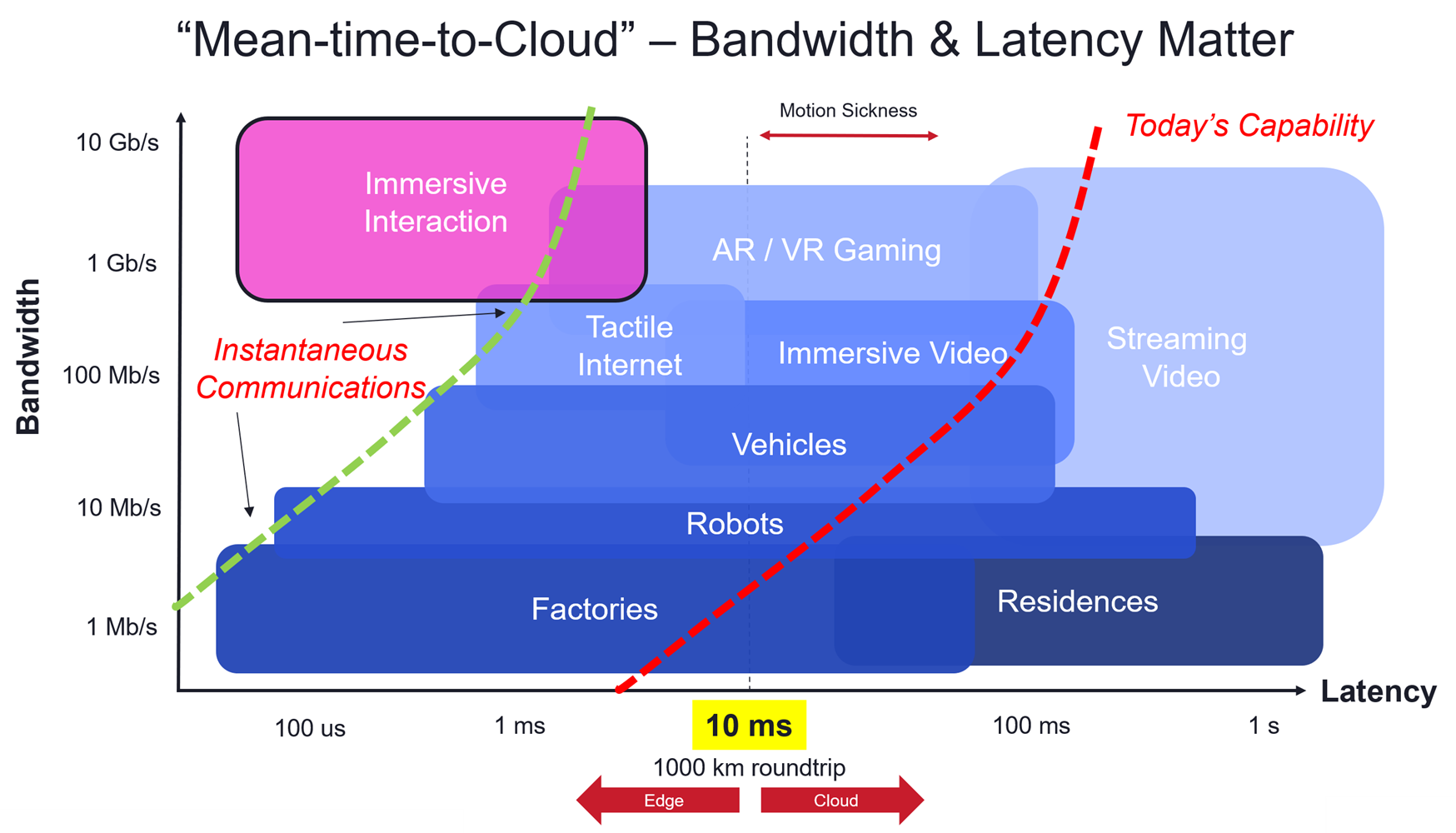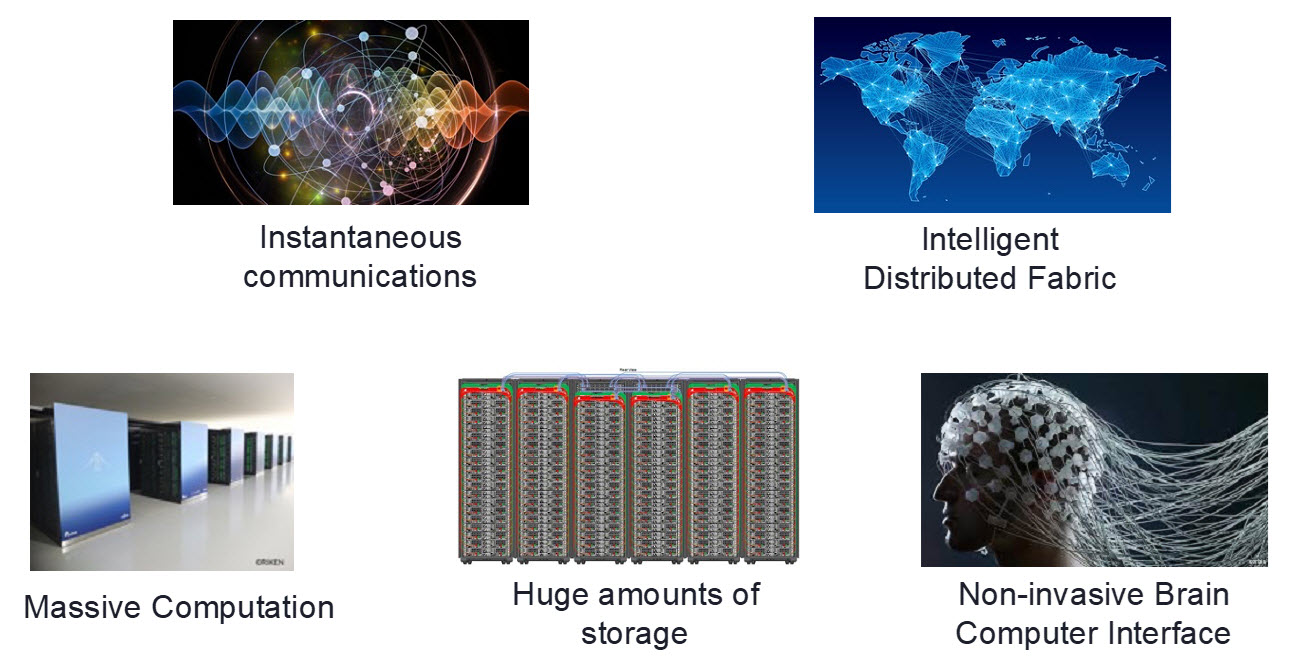Mean-time-to-cloud: Enabling a metaverse-ready network
Mean-Time-to-Cloud
Today’s applications are already pushing the limits of available bandwidth and the need for latency low enough to provide high quality experiences. The product of these two parameters, bandwidth and latency, define a network measurement Ciena refers to as “Mean-Time-to-Cloud.” This attribute combines the amount of data to be transferred to the Cloud, the time to process that data, and then the time to return it to the user. The goal is to use this metric to allow an application to deliver a high quality of experience.
With bounded latency also comes the concept of determinism, which allows for the controlled flow of traffic. A deterministic network is especially useful when bidirectional communications are required.

Today’s networks can deliver performance characteristics of 10s of milliseconds, but only at relatively low bandwidths. Networks can deliver large amounts of bandwidth but incur significantly more latency when doing so. This is due to the sheer amount of data being transferred: it takes time for the data to move, and it takes time for the data to be processed.
In a virtual environment, it’s at around 10ms where the lag between a user making a motion and the movement being displayed causes dizziness or motion sickness (also known as “motion-to-photon” latency), ruining any immersive experience.
To deliver the network performance to support the metaverse, the network will require massive amounts of bandwidth, coupled with huge amounts of computation and storage accessible at ultra-low latencies. This is where the transfer of data is at or below the threshold of human or machine perception, i.e. "instantaneous communications".
Ciena’s goal is to understand how metaverse applications will impact the network, as this will allow us to design future network architectures that will deliver the quality of experience required by those applications.
An adaptive network for the metaverse
One aspect of the complex network requirements needed for the metaverse is the ability to consume any application with the right level of experience on any device from anywhere. We can envision a home or residence connected to a nearby data center. Both of these points are fixed, so an easy solution that provides high bandwidth and low latency is fiber, and specifically broadband connectivity through passive optical networking (PON.)
Now envision a scenario where you’re mobile. The way you connect to the Cloud now changes: you need advanced wireless connectivity like 5G, 5G Advanced, and eventually 6G. As you move, your connected data center must change so that the application and its computation can shift to the closest data center at any particular time. To preserve the required high bandwidth and low latency, the network must shift where you connect and make sure resources remain close to you.
In addition to programmable infrastructure, the network needs to include the idea of software-defined programmable compute that defines the overlay networks used to interconnect the dynamic applications we all rely on. Ciena is leading the way in developing hardware and software to program and orchestrate the Adaptive Network.
Technology Areas
To this end, a metaverse-ready network will require improved network technology in three main areas:
- Faster and larger networks to deliver huge amounts of bandwidth to end-user applications. This will require a combination of both fiber and wireless networks, with the ability to deliver as much information through a given communications channel as is physically possible.
- Networks that put the massive amounts of computation and storage as close to the users and the applications that rely on them. This will reduce latency and keep mean-time-to-cloud in check.
- Smarter networks with automation and AI/ML to manage resources in a closed-loop manner with the ability to heal or reorganize the network quickly. This will require a self-optimizing fabric where applications dictate to the network the level of performance and the resources needed, and then the network delivers them.
As we discussed in the first blog in this series, with Web 2.0 you are connected across the network to where the application resides. With Web3, applications and functions are decentralized and don’t reside in one place. The role of the network begins to look like a fabric interconnecting these Web3 services. And to a certain extreme, the applications and their functions become embedded in the network infrastructure, allowing them to exist throughout the fabric.

The fundamental requirements of a metaverse-ready network infrastructure.
In the coming years, generative artificial intelligence will fundamentally shift the way we access and interact with information. For decades, we’ve formulated questions and queries in a way search engines will understand (“Ford Explorer dimensions trunk”). But soon we’ll be able to use natural language to work with data (“Will my new 65” TV fit in my car?”).
Imagine an intelligent avatar tool that can preserve your presence in the metaverse when you’re not online, interact with people or other avatars with your mannerism and your knowledge, and then report back to you with what transpired. This tool might even be able to conduct autonomous DeFi transactions on your behalf, function as your proxy for a DAO (decentralized autonomous organization), and even “create” for you independently with the correct training.
Even with a network to connect the required computation and storage, how this physically connects to our body will be important. Today we wear headsets, glasses, or goggles to offer photo-realistic images or augmented information to our eyes. These are bulky and uncomfortable, and can only be worn for short periods of time before fatigue sets in.
Haptic feedback via gloves or suits is rudimentary at best. Scents can be created with a squirt of mixed liquids integrated into a VR headset, but this just adds complexity to an already non-ideal solution. What will be needed is a non-invasive way to interface directly with our brains, a non-invasive brain-computer interface (BCI.)
Innovators have already begun exploring BCI techniques, but they currently require placing sensors in or near the brain. The accuracy of simply trying to understand the meaning of brain signals is based on the resolution of information gathered, which could require thousands to millions of sensors. Today’s challenge of collecting, computing, and storing large amounts of data at the metro city level will likely evolve into a scaling issue at the “body area network” level as well. Now add to this the next step after interpreting brain signals: inducing signals within the brain to produce a multi-sensory effect.
Today’s challenge of collecting, computing, and storing large amounts of data at the metro city level will likely evolve to a scaling issue at the 'body area network' level as well.
Realizing the future of the metaverse
30 years ago, who could have predicted the profound impact the Internet and mobile communications have had on the world today? Similarly, how can we predict the impact that the metaverse will have on the world 30 years from now?
The metaverse will be the evolution of the Internet. The Internet has shown us human innovation can produce unimaginable results, and the metaverse will be no different. But this will only be possible with a metaverse-ready network.
Ciena helps form the “circulatory system” of the Internet by providing the technology behind the conduits that carry information. We know the demand for higher capacity, lower latency, smaller/cheaper devices, and the push to the edge are constant network engineering challenges. We have just begun to build the metaverse, and Ciena believes the network will need to provide much more connectivity, the network will need to support huge bandwidth and massive computation (at low latencies), and will need to be controlled, operated, and orchestrated in a seamless, transparent manner.
Want to hear more? Ciena CTO Steve Alexander recently presented at MWC23 on the topic of a Metaverse-ready network, and how we get to the point where we have the ideal latency requirements and overall network performance. You can watch that session below.
This is the third blog in a three-part series around the evolution of the World Wide Web, how it can become the metaverse, and the networking requirements necessary to support it. See part 1 here: What is Web3 and how does it relate to the metaverse? and part 2 here: Making the metaverse feel real: the key characteristics and challenges









